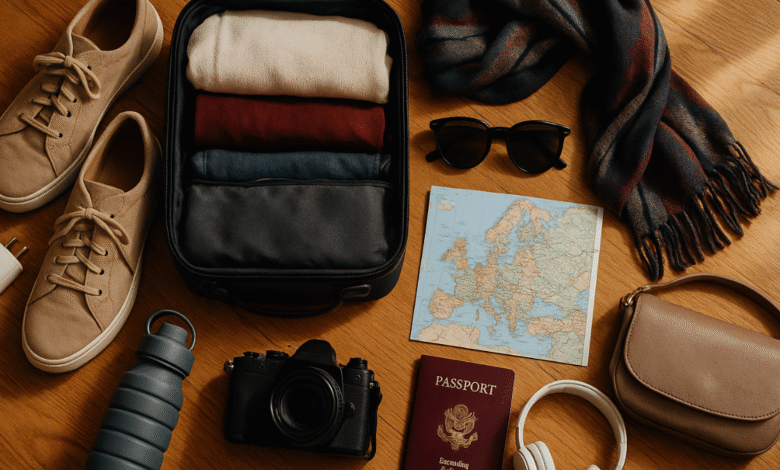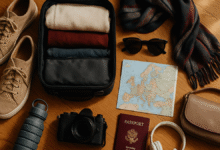What to Pack for Europe Trip: Ultimate Packing Guide for Stress-Free Travel

Discover what to pack for Europe trip with our complete guide to clothing, essentials, gadgets, and travel hacks. Pack smart, travel light, and enjoy stress-free adventures.
Traveling to Europe is an adventure that promises history, culture, cuisine, and breathtaking scenery at every turn. But before you set off, the question that every traveler asks is simple yet crucial: what to pack for Europe trip? Packing for Europe isn’t just about tossing clothes in a suitcase; it’s about being strategic. The continent has diverse climates, unique travel styles, and lots of opportunities where the right gear can make your journey smoother.
Whether you’re planning a summer escape to the Mediterranean, a chilly winter adventure in the Alps, or a spring tour of European cities, packing the right items ensures that you’re prepared, comfortable, and stress-free. This guide will walk you through the essentials, give you tips for different seasons, and even cover those often-overlooked details that can make or break your trip.
Understanding Europe’s Diverse Climates
When you start thinking about what to pack for Europe trip, the first thing to consider is the weather. Europe isn’t uniform—it has Mediterranean warmth, northern chill, mountain snow, and everything in between. That means what you’ll pack largely depends on where and when you’re going.
For instance, packing for Paris in the fall requires layers and a stylish raincoat, while heading to Spain in July demands light fabrics, sunscreen, and a sunhat. If your trip includes multiple regions—say, London, Rome, and Zurich—you’ll need a mix of items to adapt to varying climates. The key here is versatility. Lightweight layers, comfortable shoes, and travel-friendly outerwear can serve you well across different conditions.
The seasons also play a role. Spring can be unpredictable with sudden showers, while summer calls for breathable outfits. Autumn is all about cozy sweaters and scarves, and winter might demand a heavy coat, especially in northern or central Europe. Checking forecasts before you pack helps refine your list, but having versatile clothing options ensures you won’t be caught unprepared.
Clothing Essentials Every Traveler Needs
Clothing is always the first thing people think about when considering what to pack for Europe trip. But it’s not just about filling your bag with trendy outfits—it’s about packing smart.
One golden rule is to focus on layering. Europe is notorious for weather that changes throughout the day, especially in cities like London or Amsterdam. Pack a few lightweight tops, a cardigan or two, and a versatile jacket that can be worn casually or dressed up. Dark jeans, neutral skirts, or travel-friendly dresses can be mixed and matched with multiple tops. This strategy keeps your wardrobe compact yet stylish.
Also, don’t forget about shoes. You’ll likely be walking more than usual, whether it’s cobblestone streets in Italy or museum halls in Germany. Comfortable sneakers or walking shoes are non-negotiable. If you plan on going out for nicer dinners or nightlife, pack a pair of dressier shoes that are still practical. Remember, European style leans classic and chic, so you can blend in while staying comfortable.
Packing for Summer Adventures
Summer trips across Europe are a dream, but they also come with unique challenges—like intense heat, crowded cities, and endless walking. Thinking about what to pack for Europe trip in the summer requires balance between comfort and style.
Lightweight, breathable fabrics such as cotton or linen are your best friends. Pack shorts, skirts, and loose dresses that keep you cool but still presentable for cultural sites. Remember that many churches and cathedrals require modest attire, so a light scarf or shawl can be useful to cover shoulders or knees when necessary.
Don’t underestimate the sun either. A good pair of sunglasses, a wide-brimmed hat, and high-quality sunscreen are essentials. Hydration also matters, so a collapsible water bottle is a great item to carry. Pair all of this with lightweight shoes designed for long walks, and you’ll be ready for European summers without melting under the sun.
Staying Warm During Winter
Winter in Europe can be magical, especially with Christmas markets, snowy landscapes, and cozy evenings in charming cafes. But when considering what to pack for Europe trip in colder months, warmth and practicality take priority.
A durable, weatherproof coat is essential if you’re heading to northern or central Europe. Pair it with warm sweaters, thermal tops, and comfortable pants. Scarves, gloves, and a good beanie are not optional—they’ll make a huge difference when walking outside for long stretches. For footwear, insulated and waterproof boots are best, especially if you’ll be in snowy areas like Switzerland or Austria.
Don’t forget indoor comfort either. Many European homes and accommodations keep heating moderate compared to what some travelers might expect, so cozy loungewear and warm socks make downtime much more pleasant. By layering wisely and choosing pieces that can handle snow, rain, and wind, you’ll stay comfortable and enjoy winter in Europe without shivering.
Essential Travel Accessories
Clothes aside, accessories play a huge role when deciding what to pack for Europe trip. These items might not take much space, but they make your journey infinitely smoother.
A universal travel adapter is absolutely necessary. Europe has different plug types and voltages depending on the country, so having a single adapter with multiple ports saves you from hassle. A power bank for your phone is equally important, as long sightseeing days can drain batteries quickly.
Another underrated essential is a reliable daypack or crossbody bag. You’ll need something to carry your essentials—water, snacks, guidebook, camera—without weighing you down. Choosing a bag with anti-theft features, like lockable zippers, can give peace of mind in crowded areas. Pair this with a money belt or RFID-blocking wallet to keep your valuables safe while navigating busy cities.
Toiletries and Health Must-Haves
When creating your list of what to pack for Europe trip, don’t overlook toiletries and health essentials. While Europe has plenty of pharmacies and shops, it’s best to carry what you need in travel-sized containers.
Pack your personal hygiene products like toothpaste, deodorant, shampoo, and skincare. For health, a small first-aid kit with band-aids, pain relievers, and any personal medications is crucial. Motion sickness tablets might come in handy for ferry rides or winding bus trips, while sunscreen and insect repellent are must-haves depending on the season and destination.
Many travelers also swear by reusable toiletry bottles to cut down on waste and stay organized. Remember that liquids in your carry-on must follow airline restrictions, so pack smart to avoid delays at security.
Tech and Gadgets for Modern Travelers
Technology is part of travel now, and knowing what to pack for Europe trip includes a few must-have gadgets. Your smartphone will likely double as your camera, GPS, and entertainment device, but don’t rely on it alone.
A lightweight camera can be worth carrying if you’re visiting iconic landmarks. A Kindle or e-reader is perfect for long train rides, while noise-canceling headphones can save your sanity on flights. Don’t forget chargers, extra memory cards, and protective cases for all your tech.
If you’re working remotely while traveling, packing a compact laptop or tablet is wise. Pair it with a portable hotspot or SIM card that works in multiple countries to stay connected across borders. With the right gadgets, your trip can be both enjoyable and productive.
Packing Smart with Space-Saving Tips
Even if you know what to pack for Europe trip, the bigger challenge is fitting it all into one suitcase. That’s where smart packing hacks come in.
Packing cubes are game changers for organization, allowing you to separate outfits, shoes, and accessories neatly. Rolling clothes instead of folding saves space and reduces wrinkles. Using travel-sized containers for toiletries frees up even more room.
Another great tip is the “wear your bulkiest items” trick. If you’re packing boots or a heavy coat, wear them on the plane instead of stuffing them into your luggage. Not only does this save space, but it also keeps you warmer during chilly flights.
Travel Documents and Safety Essentials
Beyond clothing and gadgets, no list of what to pack for Europe trip is complete without addressing documents and safety. Passports, visas (if required), travel insurance, and printed copies of reservations are non-negotiables. Keep digital backups on your phone or in cloud storage for emergencies.
Carrying both cash and cards is also smart. While Europe is largely card-friendly, smaller towns or markets might prefer cash. A money belt or hidden pouch ensures your valuables stay safe, particularly in crowded areas prone to pickpocketing.
It’s also wise to carry emergency contact details and know how to reach your country’s embassy. A little preparation in this area can save you from stressful situations while abroad.
Table: Quick Checklist for What to Pack for Europe Trip
| Category | Essentials |
|---|---|
| Clothing | Layers, jeans, breathable tops, comfortable shoes, coat, scarf |
| Accessories | Travel adapter, power bank, daypack, money belt |
| Toiletries & Health | Travel-sized toiletries, first aid kit, medications, sunscreen |
| Tech & Gadgets | Phone, charger, camera, e-reader, headphones, laptop (if needed) |
| Travel Documents | Passport, visas, insurance, reservations, cards & cash |
| Seasonal Extras | Sunglasses & hat (summer), thermal wear & boots (winter), raincoat (spring) |
FAQs
Q: How should I pack light for Europe?
A: Focus on versatile clothing that can be mixed and matched, use packing cubes, and avoid overpacking shoes. Stick to essentials and plan to do laundry on the road.
Q: Do I need special adapters for Europe?
A: Yes. Europe uses different plug types and voltages depending on the country. A universal travel adapter with multiple ports is the best choice.
Q: What’s the best type of bag for Europe travel?
A: A crossbody bag or small daypack with anti-theft features is ideal. It keeps your essentials close and secure while exploring cities.
Q: Should I carry cash in Europe?
A: Yes, though most places accept cards. Small towns, local markets, and some restaurants may prefer cash, so carrying both is smart.
Q: What not to pack for Europe trip?
A: Avoid overpacking bulky clothes, bringing too many shoes, or carrying unnecessary gadgets. Remember that most things can be purchased locally if needed.
Conclusion
When it comes to what to pack for Europe trip, the golden rule is to pack smart, not heavy. Versatility, comfort, and practicality should guide your choices, whether it’s clothing, accessories, or travel documents. By planning ahead and focusing on essentials, you’ll enjoy your European adventure without the stress of overstuffed luggage or missing items.
The right packing strategy not only makes your journey smoother but also ensures that you can focus on what really matters—exploring Europe, creating memories, and enjoying the journey of a lifetime.



